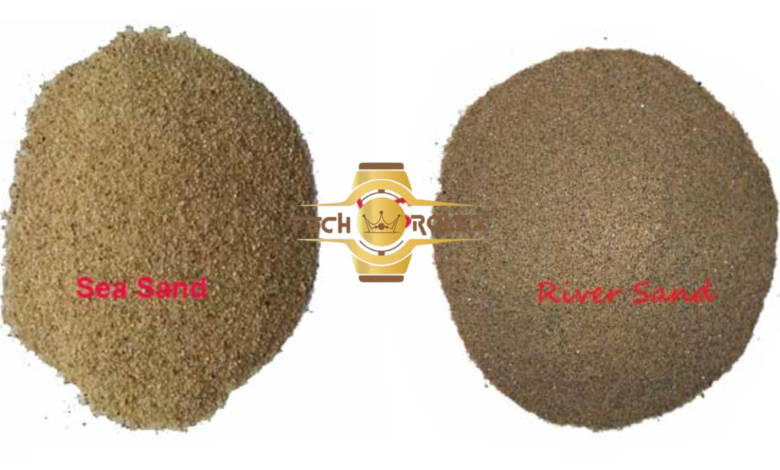What Is River Sand Mesh Size? A Simple Guide for Everyone

River sand mesh size refers to how fine or coarse sand is, based on how it passes through a mesh screen. Just like using a kitchen strainer to separate small particles from big ones, mesh size tells us how small the grains of sand are. This helps builders choose the right sand for different construction jobs like concrete, plaster, or paving.
What Does River Sand Mesh Size Mean?
Mesh size in river sand is a number that tells us how many openings (holes) are in one inch of a screen used to sieve sand. If you’ve ever used a tea strainer, then you’ve already used a version of a mesh! Just imagine the screen used to filter sand is like a super-strong tea strainer.
When we say “20 mesh sand”, it means the sand passed through a screen that has 20 openings per inch. A higher mesh number like 60 or 100 means the openings are smaller, so the sand is finer. A lower mesh number like 10 or 16 means bigger openings, so the sand is coarser.
In construction, different mesh sizes are chosen depending on the task. Finer sand is used for finishing or plastering, while coarser sand is ideal for concrete mixing.
Why Mesh Size Is Important in Construction
The mesh size of river sand affects the strength, texture, and finish of the building material it is used in. Just like how the right flour texture makes better cake, the right sand texture makes stronger concrete or smoother plaster.
Builders and engineers need to know the correct sand particle size to match the purpose of the project. Using the wrong sand size can lead to cracks, poor bonding, or even weak structures.
For example:
- Fine mesh river sand is ideal for tile work, wall plastering, and finishing layers.
- Medium mesh sand works best for blockwork and mortar.
- Coarse sand with lower mesh number is better for concrete, drainage layers, and foundations.
How Mesh Size Works – Like a Kitchen Strainer
Let’s simplify it: Mesh size works exactly like a strainer in your kitchen. Imagine pouring flour into a strainer with big holes. Only the large chunks will stay on top, and the fine powder falls through. The same happens with sand.

Mesh screens are made of woven wires, and each screen has a specific number of holes per inch. This number is called the mesh number.
What Is a Mesh Number?
The mesh number tells you how many tiny holes are in one linear inch of a screen:
- A 10 mesh screen has 10 holes per inch — big holes, large sand particles.
- A 50 mesh screen has 50 holes per inch — smaller holes, finer sand.
- A 100 mesh screen has very fine holes, allowing only very small grains to pass.
In the United States, mesh size follows ASTM standards, which help ensure uniformity in sand particle grading.
Fine vs Coarse Sand
- Fine river sand has a mesh size between 40 to 100 mesh. It’s soft and smooth, used in plastering and finishing.
- Coarse river sand ranges from 4 to 20 mesh. It has bigger grains, ideal for structural use like concrete and foundation work.
A simple way to remember:
- Higher mesh = finer sand.
- Lower mesh = coarser sand.
Choosing the Right Sand for the Job
Let’s match mesh size to real-world uses:
- Plastering walls? Use 60 to 100 mesh fine river sand.
- Laying concrete? Use 10 to 30 mesh coarse sand.
- Making mortar? Use 30 to 50 mesh medium sand.
- Filtration or paving base? Use a mix of mesh sizes (graded sand).
Choosing the wrong mesh size can ruin your finish or weaken your concrete, so it’s important to pick the right one.
Mesh Size Examples for River Sand
Here are some real-world examples of river sand mesh sizes and their uses:
- 4 mesh to 10 mesh: Large gravel-like particles, used for drainage layers or decorative landscaping.
- 10 mesh to 20 mesh: Coarse sand, used in concrete mix and road base.
- 20 mesh to 40 mesh: Medium sand, ideal for brickwork and paving jobs.
- 40 mesh to 60 mesh: Fine sand, used for plastering and finishing coats.
- 80 mesh to 100 mesh: Ultra-fine river sand, sometimes used in tiles, ceramics, and polishing works.
In many US construction projects, 20 mesh river sand and 40 mesh river sand are most commonly used.
Sieve Size of Sand – How It’s Measured
To measure river sand size, we use a stack of sieves – each with smaller holes than the one above it. The sand is shaken through the sieves and categorized based on which screen it passes through.
This method is called sieve analysis, and it’s done using standardized equipment. It helps in grading the sand and checking whether it meets building codes.
Each sieve size has a number and aperture size (in mm or microns). For example:
- No. 4 sieve = 4.75 mm
- No. 10 sieve = 2.00 mm
- No. 40 sieve = 0.425 mm
- No. 100 sieve = 0.150 mm
By using these sieves, we can classify the sand accurately and ensure it’s right for the job.
Where River Sand Comes From
River sand is formed naturally over thousands of years. It is carried by flowing rivers from rocks, mountains, and riverbeds. The water breaks down larger rocks into tiny particles.

This process results in smooth, rounded sand grains that are ideal for construction.
Natural Process of Sand Making
Sand starts as larger rocks that weather down due to wind, rain, and river flow. The friction and movement in rivers break the rocks into smaller and smaller pieces.
Over time, these particles are polished and rounded, creating natural sand. This type of sand is clean, chemically stable, and perfect for concrete and mortar.
Clean and Ready for Use
Before river sand is used, it goes through washing and grading. Washing removes mud, clay, or organic matter. Then, it’s passed through mesh screens to separate different sizes.
This is where mesh size comes in — separating coarse, medium, and fine sand for various uses.
Types of River Sand Based on Mesh Size
Here are the common types:
- Washed Coarse River Sand (4–10 mesh) – For base layers, foundations, and concrete mix.
- Medium Washed River Sand (20–40 mesh) – Ideal for block laying and general construction.
- Fine Washed River Sand (60–100 mesh) – Used for plastering and finishing work.
Some specialty sands like filtration sand also follow strict mesh size requirements.
River Sand Mesh Size for Different Uses
Different construction activities require different sand sizes:
Use CaseIdeal Mesh Size
Concrete Mixing 10 to 30 mesh
Plastering Walls 60 to 100 mesh
Paving and Flooring Base 20 to 40 mesh
Filtration Systems 40 to 80 mesh
Masonry Work 30 to 50 mesh
Tile Adhesive 60 to 80 mesh
Landscaping or Filling 4 to 16 mesh
So, mesh size = match it to the job.
For example:
- A 40 mesh river sand might be too fine for structural concrete but perfect for plaster.
- A 20 mesh sand might be too coarse for plaster but great for road base.
The Bottom Line
Understanding river sand mesh size is key to building better, stronger, and more durable structures. It’s like choosing the right ingredients for a recipe — use the right one and your building stands the test of time.
Mesh size tells us how fine or coarse the sand is, which helps decide whether it’s fit for concrete, plaster, or another use. Builders and homeowners in the United States can trust standard mesh grading to choose the right sand for their needs.



